A Façade Dubbed Peace
By Daniel Park
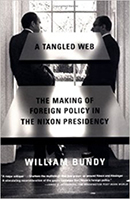
Pierre Asselin
Pierre Asselin is a professor at Hawaii Pacific University with a PHD from University of Hawaii. He teaches courses on the Cold War, diplomacy in the US, and the Middle East. His most recent work, Hanoi’s Road to the Vietnam War, 1954-1965, continues his analysis of Vietnam from the perspective of the Vietnamese.

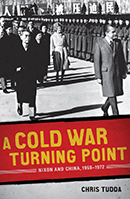

The Paris Peace Accords were an agreement to end U.S. involvement in the Vietnam War. Although it gave the impression of collective amicability as U.S. troops were pulled out, nothing could be further from the truth. Pierre Asselin delineates the tensions between the two sides and the failure of the Peace Accords to serve their purpose in his book, A Bitter Peace. Claiming that “Peace … never had a chance in Vietnam,” Asselin traces the diplomacy leading up to the Paris agreement.1 Exploited to serve “certain immediate, cynical purposes” by both sides, the treaty was ephemeral and impotent.2 What was named an “agreement” had very different definitions by all parties involved as the wording of several points was left intentionally vague to gain the approval. This was exacerbated by the fact that the Accords were written in both Vietnamese and English and that the two copies were not necessarily congruent in text and meaning. The discrepancy between understandings destroyed the Paris Peace Accords. However, the Peace Accords’ failure was also a result of the actions leading up to it. By analyzing the period between 1968 to 1975, Asselin depicts “the circumstances that doomed the peace promised by the agreement.”3
Diplomatic action before 1968 played a minor role in the creation of the Paris Agreement. During this time, diplomacy was not stressed in Washington and belittled by Hanoi. The war was still in its beginning phases and each side felt confident that military force could achieve victory. With major differences between the two, “neither party was prepared to compromise, or even negotiate properly.”4 Thus the armies became entangled in a deadlock that could only be resolved by force. In 1968, the National Liberation Front of South Vietnam (NLF), also known as the Viet Cong, launched the Tet Offensive. The attack consisted of several simultaneous assaults on military bases in South Vietnam. Despite ending in failure with heavy losses for the NLF, the attack did succeed in shifting the American public’s support away from the war by “shatter[ing] the myth that allied armies were winning the war.”5 This lead to increased diplomatic efforts as Washington asked Hanoi to withdraw their forces from the South. Hanoi circumvented responsibility by lying, claiming that the NLF was an independent fighting force over which they had no jurisdiction over the NLF. Despite the lack of a serious diplomatic approach, the Tet Offensive did break the military stalemate and opened up communication lines between the two capitals. As discussions continued, the talks expanded to include the NLF and the current Government of (South) Vietnam (GVN) as America hoped to resolve the Vietnam War with the cooperation of the Vietnamese. Nixon continued this idea in his policy of Vietnamization which sought to “enlarge the South Vietnamese role in and responsibility for the military side of the war … while simultaneously reducing the American role and responsibility.”6 Seen as a “compromise [to] the eventual reunification of the country,” the Democratic Republic of (North) Vietnam (DRVN) turned increasingly towards diplomacy to resolve issues on the battlefield.7
In 1972, Nixon changed his approach by applying pressure not only on Hanoi directly through frequent bombings, but also indirectly through its allies as well. By improving relations with China and the Soviet Union, Nixon sought to use them to convince Vietnam to seek peace: “‘though rapprochement with China and détente with the Soviet Union were ends in themselves, [Nixon] also considered them possible means to hasten the end of the war.’”8 As such Nixon sent his National Security Advisor, Henry Kissinger, to both countries to appeal for support in convincing the DRVN to seek an end to the fighting in Vietnam. Fearful of the effects of a U.S. and Soviet or China bond and aware of the coming 1972 election, the DRVN launched a massive military campaign called the Spring Offensive. Originally successful, the Spring Offensive was countered by Nixon’s operation Linebacker: the continuous and massive bombing of Hanoi and Haiphong. Different from previous operations, Nixon’s bombing was “‘in sharp contrast to the extensive and vacillating restrictions in existence during Rolling Thunder.’”9 It bombed previously spared regions and shook the industrial base the revolutionaries desired. However, neither the Soviet Union nor China threatened to break their new link with the United States. This came as a heavy shock to Hanoi where many believed that Nixon “‘would never dare bomb Hanoi or Haiphong for fear of Soviet reaction to such attacks.’”10 Only after the Spring Offensive had been repelled and the constant bombings threatened to “destroy the progress made since 1968 in reconstructing heavy industry and in so doing threaten the socialist base of the North Vietnamese state – and the Revolution,” did the DRVN begin to consider a diplomatic solution.11 Diplomatic talks began to include the possibilities of a cease-fire, exchange of prisoners of war (POW), cessation of bombing, and removal of the U.S. from the war. The losses from the Spring Offensive, the Vietnamization of the war, the improving relations between the U.S. and Hanoi’s allies, and the damage of continued bombing all contributed to Hanoi’s desire to settle an agreement quickly.
In its attempt to end the war quickly, the DRVN made several concessions, but the agreement still required several hours of bargaining. On October 11, an agreement requiring the signatures of the DRVN, NLF, GVN, and U.S. was drawn. The treaty included a cease-fire, U.S. withdrawal from Vietnam, termination of foreign aid, return of POWs, and gave self-determination to the South Vietnamese. The treaty did not officially include reference to DRVN forces in the South and “excluded those forces from the jurisdiction of the agreement.”12 In other words, North Vietnamese soldiers were allowed to remain in South Vietnam even after the United States left. Upon reading the treaty, Nguyen Theiu, president of the GVN, was “incensed at the concessions Kissinger had made to satisfy the DRVN at the expense of the GVN.”13 He refused to sign the treaty, forcing the war to continue and creating a schism between the Washington and Saigon, the capital of the GVN. In an attempt to persuade Thieu, operations Enhance and Enhance Plus sought to “‘enhance’ the fighting capabilities of the GVN and its military forces” before the cease-fire was signed, giving Saigon a better chance to defeat Hanoi. Despite offers to make changes, Kissinger failed to convince Thieu to sign the agreement: “he would not accept the present agreement or any other agreement, and his decision was final.”14 Despite the growing gap between Washington and Saigon, the U.S. did not sign a separate treaty with the DRVN and continued to send aid to the South. The continuation of the war led the DRVN to turn back to military force and convinced Nixon that “[they] must have a settlement or Congress would end aid to Saigon and let the war run its course without further American involvement.”15 Through the threat of potential Congressional interference, Nixon attempted to pressure Thieu to reconsider an agreement, but failed to change his mind.
By bombing Hanoi and threatening to end aid to Saigon, Nixon hoped to steer the two towards an agreement. Whenever diplomatic talks were stalled with Hanoi, Nixon would respond with B-52 bombers that destroyed much of Saigon. Culminating during late December, these attacks became known as the Christmas bombings and resulted in hundreds of civilian casualties: “the planes dropped 4,000 tons of bombs, leveling among other sites, accidentally or deliberately, Kham Thien Street in a densely populated area of Hanoi.”16 Although these attacks applied pressure to Hanoi, they also whittled away support for the war. Congress, countries, and people all began to express disapproval for Nixon’s actions. Nixon also applied pressure to Thieu with undisguised threats to end aid: “you must decide now whether you desire to continue to work together or whether you want me to seek a settlement with the enemy which serves U.S. interest alone.”17 Faced with no other option, Thieu agreed to sign the Paris Agreement, ending U.S. involvement in South Vietnam. Signed merely to bring an end to U.S. involvement, the treaty was “an end in itself for both Washington and Hanoi.”18 It left behind a military fiasco that threatened Saigon and “within six months … the agreement would result in a Communist government in South Vietnam.”19 Even when Hanoi violated the cease-fire delineated by the treaty, the U.S. failed to respond: “Clearly, Washington was more concerned about the return of … prisoners than ending the conflict in Vietnam or enforcing the peace agreement.”20 Shortly afterwards, the Revolution triumphed and Saigon fell.
In depicting the progress of events leading to the Paris Agreement, Pierre Asselin seeks to shed light on the circumstances that lead to its failure. He includes military campaigns, but focuses on diplomatic actions of ambassadors. Thus, Asselin believes that although military action was influential, the negotiations between both sides for concessions marks the true struggle the U.S. faced towards the end of the war. The goal was no longer military victory but peace with honor which Kissinger emphasized: “It is essential that we leave Vietnam as an act of governmental policy and with dignity, not as a response to pressures and in the form of collapse.”21 Thus, Kissinger sought an “agreement that softened the blow of defeat and thereby avoided the most obvious consequences of capitulation to American credibility.”22 The result was the Paris Peace Accords. Therefore, the accords were created for the sole purpose of extricating the U.S. from the Vietnam War, but failed to create any permanent changes and ultimately failed in its role.
Within his work, Asselin uses several primary sources as evidence for his reasoning. His quotes from private talks and his analysis of secret discussions was made possible through a combination of Vietnamese texts and documents from the U.S. and China. However, as he uses documents from each side, he retains a sample of their biases in the descriptions of the events. As was noted of the Paris Peace Accords, each side had their own interpretation of articles within the agreement. Asselin even notes a distinct contrast between notes from Vietnam and the U.S. on a particular event. Each side argued that the other ambassador had conceded first in one of the meetings. As the one analyzing the text, Asselin was not spared the biases hidden within each document. In fact, most of the documents Asselin used for discussions on the Vietnamese side came from “editorials, speeches, letters to cadres and official histories, [which] do not provide requisite information on decision-making and policy-making.”23 In addition, these sources held their own biases and views towards their country and the foreign U.S.
Asselin was influenced by his setting when writing this work. Looking back upon the Paris Peace agreement, he argues that it was a failure as it did nothing beyond allowing the U.S. to leave the war. Looking back from the present, Asselin is armed with the insight that the treaty would not be adhered to and that Saigon would soon fall to the revolution. This makes Asselin more critical when informing the reader of the results of the Paris Agreement. It’s important to note that Asselin did not live through the Vietnam War as a young man and does not consider the number of American soldiers spared when assessing the success of the Paris Peace Agreement. Asselin is also able to delve deeper into the inner workings of each side that pushed them towards their decisions from “previously unavailable U.S., Vietnamese, and Canadian primary sources.”24 These documents aid Asselin in his analysis of the two opposing viewpoints that bartered for concessions and may have pushed him to publish his work on the Paris agreement. In a time period where people began to observe history from other perspectives that were no longer Americentric, Asselin includes the viewpoints of the Vietnamese, who were still considered the enemy even after the war.
Pierre Asselin’s work has been reviewed by several critics, Praised for his perspective on both sides of the agreement, Asselin gains credibility for his use of Vietnamese texts rather than solely relying on English translations. Jeffrey Kimball, an author who also focused on Nixon’s involvement in the Vietnam War, commented, “Asselin is also to be commended for carrying out research in Vietnam, translating Vietnamese sources and attempting to tell the story of the Paris negotiations from both sides.”25 Another reviewer states that Asselin used “previously unavailable U.S., Vietnamese, and Canadian primary sources,” which brought about a more “balanced perspective to reporting the negotiations.”26 Asselin’s reliance on historical documents creates a textual foundation for his claims; however, his analysis is still subject to criticism. Kimball continues on to claim that “Asselin breaks little new ground in explaining the convoluted progress of the negotiations and their dubious outcome.”27 Scott T. Cairns from the London School of Economics suggest “Asslein’s critique of Nixon and Kissinger is, perhaps, too lenient,” as Asselin fails to criticize Nixon’s broken promises of ending the war or his order to proceed with the Christmas bombing which injured hundreds of innocent civilians.28 In short, Asselin is praised for his research and translations, but his book draws disapproval in its claims and bias on certain positions.
Despite its shortcomings and the criticism it drew, Asselin’s book is an excellent source of information on the Paris Peace Accords and their creation. His multiple perspectives and clear diction creates a solid understanding of diplomacy in the Vietnam War. Cairns describes the book as “well written and highly readable,” and adds that “his style of writing makes the work easily accessible to both newcomers to the subject as well a more knowledgeable historians.”29 By limiting his language and broadening his audience, Asselin allows his book to appeal to students and historians and present his view on the Paris Peace Agreement. By presenting the discussions between the two countries and their representatives, Asselin creates a powerful argument for diplomacy’s importance in the Vietnam War. Asselin also adds military events which precede or result from diplomatic actions. By interconnecting military force and diplomacy, Asselin reveals the unseen part of the war.
In describing the Vietnam War before the Paris Peace Accords, Asselin analyzes the 1970s and contrasts them to their predecessor, the 1960s. The 1960s saw the beginning stages of a war which would lead to a decade of struggle. It began the escalation of the war and resulted in the 1970s and the very entanglement which the Peace Accords sought to extricate Nixon from. The 1970s marked not only a new president, but also a new aggressive strategy. Whereas Johnson was wary, Nixon was aggressive. He claimed that “‘If we are going to strike the enemy… then we should strike hard at its heart and keep on striking until the enemy’s will has broken.”30 This contrast is reflected in Nixon’s total war bombing style, which consisted of openly bombing industrial centers and occasionally civilian towns. These military operations reinforced the chaotic times of the 1970s and divided public support for the war. Just as the American government and public were divided, so were the 1970s divided from the 1960s. The War became less concerned with the protection of South Vietnam and became more concerned about the lives of American soldiers both accounted for and missing. America’s views shifted from externally in the 1960s to internally in the 1970s for the reasons Asselin delineates and creates a clear distinction that separates the 70s from all other decades.
In conclusion, Pierre Asselin assesses the success of diplomacy within the Vietnam War and in the creation of the Paris Peace Treaty. While some disagree with his conclusion of the “futile commitment to South Vietnam,” it has been generally suggested that Asselin’s use of resources is exemplary which allows him a strong foothold to bump up his arguments and present readers with the history of the Paris Peace Agreement from multiple angles.31
Footnotes:
- Asselin, Pierre. A Bitter Peace: Washington, Hanoi, and the Making of the Paris Agreement. The University of North Carolina Press, 2002. 190.
- Asselin, Pierre. xi
- Asselin, Pierre. xi
- Asselin, Pierre. 4
- Asselin, Pierre. 5
- Asselin, Pierre. 21
- Asselin, Pierre. 22
- Asselin, Pierre. 35
- Asselin, Pierre. 49
- Asselin, Pierre. 50
- Asselin, Pierre. 50
- Asselin, Pierre. 82
- Asselin, Pierre. 90
- Asselin, Pierre. 96
- Asselin, Pierre. 120
- Asselin, Pierre. 150
- Asselin, Pierre. 148
- Asselin, Pierre. 154
- Asselin, Pierre. 148
- Asselin, Pierre. 183
- Asselin, Pierre. 24
- Asselin, Pierre. 189
- Kimball, Jeffrey. Fighting and Talking. Blackwell Publishing, Inc. 2003. 764
- Cairns, Scott T. 202
- Kimball, Jeffrey. 764
- Cairns, Scott T. 202
- Kimball, Jeffrey. 765
- Cairns, Scott T. 202
- Cairns, Scott T. 202
- Asselin, Pierre. 51
- Asselin, Pierre. 189
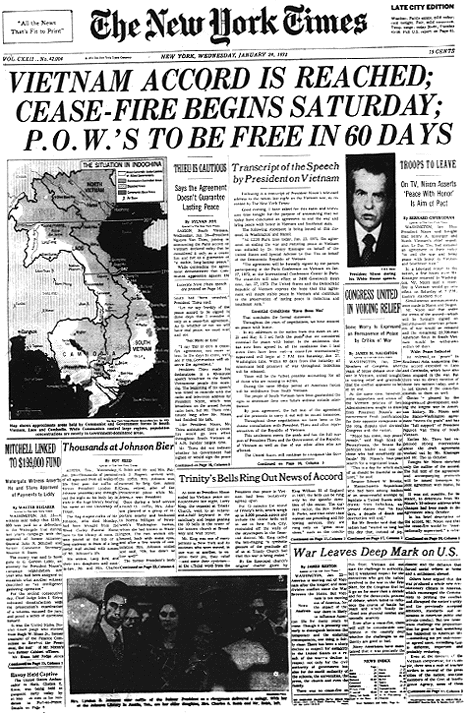
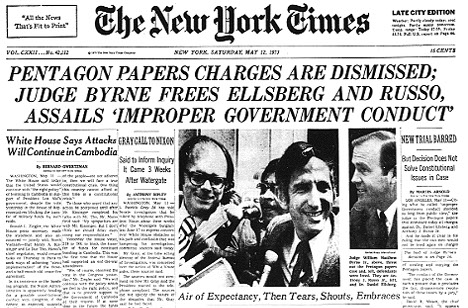
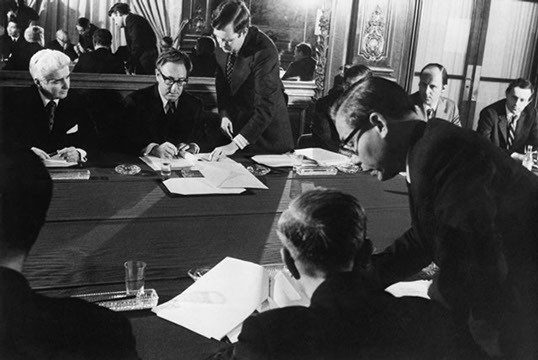

1 - 4
<
>